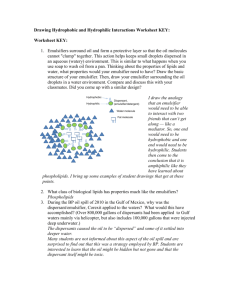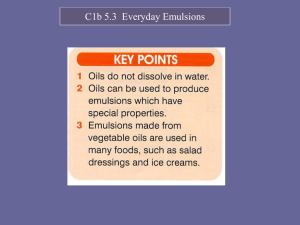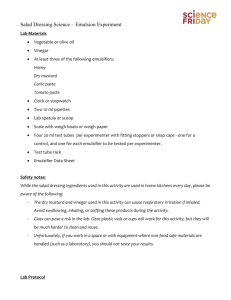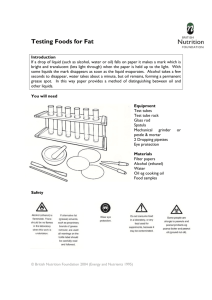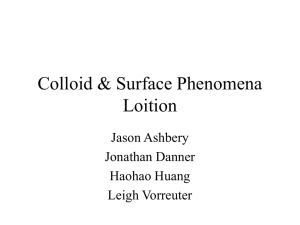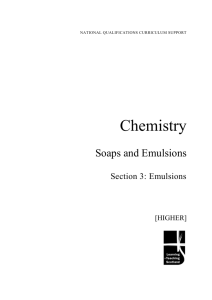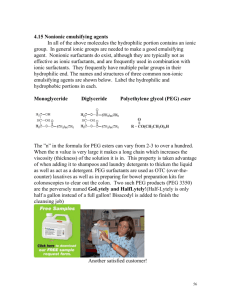Advance Journal of Food Science and Technology 9(4): 243-248, 2015
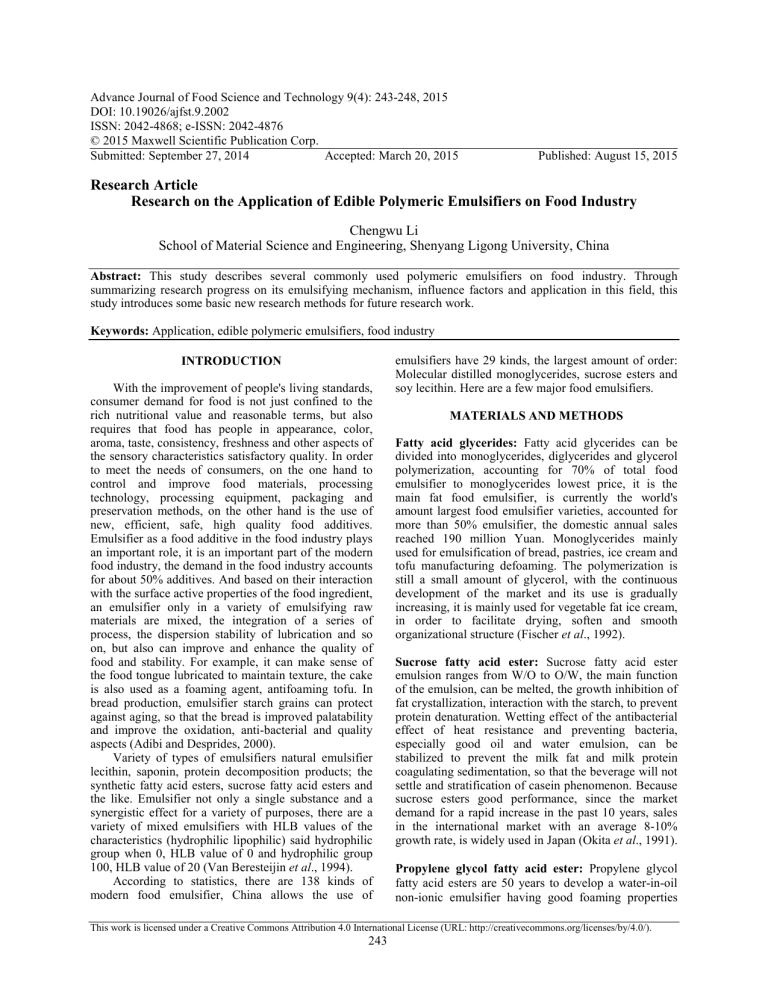
Advance Journal of Food Science and Technology 9(4): 243-248, 2015
DOI: 10.19026/ajfst.9.2002
ISSN: 2042-4868; e-ISSN: 2042-4876
© 2015 Maxwell Scientific Publication Corp.
Submitted: September 27, 2014 Accepted: March 20, 2015
Research Article
Published: August 15, 2015
Research on the Application of Edible Polymeric Emulsifiers on Food Industry
Chengwu Li
School of Material Science and Engineering, Shenyang Ligong University, China
Abstract: This study describes several commonly used polymeric emulsifiers on food industry. Through summarizing research progress on its emulsifying mechanism, influence factors and application in this field, this study introduces some basic new research methods for future research work.
Keywords: Application, edible polymeric emulsifiers, food industry
INTRODUCTION
With the improvement of people's living standards, consumer demand for food is not just confined to the rich nutritional value and reasonable terms, but also requires that food has people in appearance, color, aroma, taste, consistency, freshness and other aspects of the sensory characteristics satisfactory quality. In order to meet the needs of consumers, on the one hand to control and improve food materials, processing technology, processing equipment, packaging and preservation methods, on the other hand is the use of new, efficient, safe, high quality food additives.
Emulsifier as a food additive in the food industry plays an important role, it is an important part of the modern food industry, the demand in the food industry accounts for about 50% additives. And based on their interaction with the surface active properties of the food ingredient, an emulsifier only in a variety of emulsifying raw materials are mixed, the integration of a series of process, the dispersion stability of lubrication and so on, but also can improve and enhance the quality of food and stability. For example, it can make sense of the food tongue lubricated to maintain texture, the cake is also used as a foaming agent, antifoaming tofu. In bread production, emulsifier starch grains can protect against aging, so that the bread is improved palatability and improve the oxidation, anti-bacterial and quality aspects (Adibi and Desprides, 2000).
Variety of types of emulsifiers natural emulsifier lecithin, saponin, protein decomposition products; the synthetic fatty acid esters, sucrose fatty acid esters and the like. Emulsifier not only a single substance and a synergistic effect for a variety of purposes, there are a variety of mixed emulsifiers with HLB values of the characteristics (hydrophilic lipophilic) said hydrophilic group when 0, HLB value of 0 and hydrophilic group
100, HLB value of 20 (Van Beresteijin et al ., 1994).
According to statistics, there are 138 kinds of modern food emulsifier, China allows the use of emulsifiers have 29 kinds, the largest amount of order:
Molecular distilled monoglycerides, sucrose esters and soy lecithin. Here are a few major food emulsifiers.
MATERIALS AND METHODS
Fatty acid glycerides: Fatty acid glycerides can be divided into monoglycerides, diglycerides and glycerol polymerization, accounting for 70% of total food emulsifier to monoglycerides lowest price, it is the main fat food emulsifier, is currently the world's amount largest food emulsifier varieties, accounted for more than 50% emulsifier, the domestic annual sales reached 190 million Yuan. Monoglycerides mainly used for emulsification of bread, pastries, ice cream and tofu manufacturing defoaming. The polymerization is still a small amount of glycerol, with the continuous development of the market and its use is gradually increasing, it is mainly used for vegetable fat ice cream, in order to facilitate drying, soften and smooth organizational structure (Fischer et al ., 1992).
Sucrose fatty acid ester: Sucrose fatty acid ester emulsion ranges from W/O to O/W, the main function of the emulsion, can be melted, the growth inhibition of fat crystallization, interaction with the starch, to prevent protein denaturation. Wetting effect of the antibacterial effect of heat resistance and preventing bacteria, especially good oil and water emulsion, can be stabilized to prevent the milk fat and milk protein coagulating sedimentation, so that the beverage will not settle and stratification of casein phenomenon. Because sucrose esters good performance, since the market demand for a rapid increase in the past 10 years, sales in the international market with an average 8-10% growth rate, is widely used in Japan (Okita et al ., 1991).
Propylene glycol fatty acid ester: Propylene glycol fatty acid esters are 50 years to develop a water-in-oil non-ionic emulsifier having good foaming properties
This work is licensed under a Creative Commons Attribution 4.0 International License (URL: http://creativecommons.org/licenses/by/4.0/).
243
Adv. J. Food Sci. Technol., 9(4): 243-248, 2015 and emulsifying properties. It is made of propylene glycol and edible fatty acids 200°C, alkali catalysis, amount of emulsifier. Emulsion stability factors are: the use of emulsifiers, the stability of the interfacial film, vacuum action esterified products. Grease is applied to the bubble, the bubble stability, can make cakes, whipped cream, butter and baked goods and foaming product quality such as the shape stability are the viscosity of the dispersion medium and an emulsifier and so charged. Destabilization of the emulsion may be due to flocculation, aggregation, coalescence and layered with one or several factors. improved. But its degree of emulsification weaker than other emulsifiers, in most cases with the fatty acid monoglycerides and used, at present, domestic demand
900t.
Polymeric Emulsifier use, in addition to increasing the affinity of the dispersed phase and the dispersion medium, reduce the interfacial tension, but also increase the viscosity of the dispersion medium.
Stearoyl lactylate: Stearoyl lactate is the calcium salt
According to Stockes formula: of lactic acid condensation with stearic acid acylated after the formation of calcium is the main component of the anionic emulsifier for the bread, bread, flour and other products, mainly from the improvement of air bubbles, strengthening the dough effect (Liu et al .,
1999).
Lecithin: Lecithin from soybeans and egg yolk, mostly from soybean, commonly referred to as soybean lecithin, also called new vitamins, crude product as a paste. Lecithin is the only product other than gender synthetic emulsifiers, not only has emulsifying, dispersing, wetting characteristics, such as surfactants production, but also has a functional role in anti-aging, anti-oxidation. Soy lecithin used in chocolate, cream, butter and curry and egg yolk lecithin for the stability of ice cream.
Protein emulsifier: Protein emulsifier does not require labeling of natural emulsifiers, additives under stress without spending trends, the demand grew steadily.
Japan's Katayama Chemical Industry Institute of wheat flour and water with the production of emulsifiers decomposition products-CALUNPARA, because noodle, bread class demand growth, doubling its consumption, the annual demand for 350t.
Ideal emulsifier and the aqueous phase should have a strong affinity for the oil phase and an emulsifier is difficult to achieve this ideal state, the value is generally large and a small value of the emulsifier mixture of emulsifiers used to make Cost to expand the scope and increase its scope, can achieve better results
(Santiago et al ., 1996).
The properties of polymeric emulsifiers: Preparation in everyday life stable emulsions or break the emulsion is frequently encountered, such as the preparation of ice where,
•
=
υ g (
ρ
1
−
18
ρ
η
2
) D
2
(Re <
is settling velocity, viscosity, D
0
η
.
4 )
(1)
is the dispersion medium
is the diameter of the dispersed particles, is the acceleration due to gravity and ρ
1
and ρ
2 is the proportion of the dispersed phase and the continuous phase. When visible η increases, it can reduce the dispersed droplets of benevolence and floating rate of decline, to prevent the coalescence of droplets in the emulsion leaving stable. Meanwhile, the emulsifier can be adsorbed oil-water interface, it can improve the mechanical properties of the interfacial film, the filmforming solid interface, which for the greater contribution to the stability of the emulsion. Compared with the low molecular weight emulsifier, the emulsifier is not only the nature of the polymer-related to molecular weight, with the (Matsudomi et al ., 1995):
•
• Foaming power is poor, but the formation of the foam stability; good
•
•
•
υ
A high molecular weight, penetration weak g
The ability to reduce the surface tension of the small (interfacial tension), the majority do not form micelles
Emulsifying power; excellent
Dispersion force or cohesion
The majority of low toxicity
Natural polymer molecular weight emulsifiers, Jen cannot neatly arrange in the interface. Thereby reducing the surface tension is not great. It can improve the body of the various components of the emulsion surface tension between them, so as to form a uniform dispersion or emulsion of the body, thereby improving cream, mayonnaise and cream food preparation with milk. The emulsion is a thermodynamically unstable system, a large phase interface is present in the droplets of the dispersed phase of the dispersion medium in order to reduce the tendency to aggregate with automatic interfacial free enthalpy (Kato et al ., 1993).
To make it a uniform system, need to add a certain the food structure, on a sense, the appearance, in order to improve the storage stability of food. In addition, as an emulsifier, but also as a thickener, stabilizer, filmforming natural polymer, etc., may be used in food emulsifiers acacia, yellow gum, casein, sodium caseinate and alginic acid propylene glycol vinegar.
Natural polymer emulsifier itself is non-toxic or
244
Adv. J. Food Sci. Technol., 9(4): 243-248, 2015 nutrients needed by the body, although there are polysaccharides and binding proteins. Generally shortcomings of high prices, but in the food industry, but ultimately they are.
Arabic gum: Arabic Gum is a natural acacia tree trunk or bark exudate injury exudates collected. Most are from the Arabic gum Arabic gum in come. Composed mainly of a polysaccharide gum Arabic, it contains a salt of the considered tragacanth consists of two parts: soluble in water, arabinogalactan and only water-swollen tragacanth acid (Dickinson and Semenova, 1996).
The lower surface tension tragacanth solution system, when used in an oil-in-water emulsion system stabilized, 0.2% of the added amount of the system can reduce the surface tension to below 50%, an HLB value of 12. In the low concentration range, with increasing acid polysaccharide complex to calcium, magnesium, potassium and other ions, which also contains part of the protein. Lon de Pinto and other parts of gum Arabic by paper chromatography after hydrolysis were confirmed, identification and 13 CNMR which contain galactose, arabinose, glucuronic acid, etc., the core part of the branchedβ - (1, 3) galactose main chain. Picton, respectively, by size exclusion chromatography (Size exclusion chromato-graphy) and flow field flow fractionation (flow field flow fractionation) connected concentration, the surface tension of a sharp decline. Its molecular structure and its HLB value of 12 is not consistent, some people think that the presence of amorphous and crystalline regions rough area tragacanth, in the hydration process, the amorphous region of the water molecules than the crystalline regions of the water molecules have a greater affinity, the first hydration, the equivalent hydrophilic group. At least another portion of the crystalline region remains intact in the solution which acts as the oleophilic group. multi-angle laser light scattering method (multi-angle laser light scattering) to study the Arabic gum polydispersity the results of the former can be effectively separated with galactose and galactose protein complexes, protein complexes portion galactose void fraction was washed out of the column (Tanaka et al ., 1999). Meanwhile in the determination of the molecular properties of gum Arabic, the former can only
Ability and good emulsifying properties Huang Qiang form a viscous solution of gum swells in water so that it is widely used in the food industry. Its role is a suspending agent, thickener, adhesive, but also is an emulsifier. It can be used as condiments, beverages, ice cream and other products with roast.
Casein and sodium caseinate: Casein is adjusted with an acid at room temperature, the skim milk to the isoelectric point of the protein precipitated. It is not a get part of the information and then a method to get complete information. Than gum Arabic and the hydrodynamic radius of gyration measured radius is 0.8, indicating that it is a spherical conformation.
Emulsification properties of gum Arabic, gum Arabic in the aqueous solution in an oil-water interface can be formed into a film, can form an oil-in-water emulsion.
This may be due to the protein portion contained in the molecular structure can be effectively adsorbed on the oil droplets, thereby forming amphipathic difficulties. single protein, according to the electrophoretic migration rate can be divided into α β - and γ -Casein. In the milk, it is in the form of calcium phosphate complexes of casein exists, can be self-polymerized to form micelles. Sodium caseinate is treated with an alkali
(sodium hydroxide) rennet casein, the casein into soluble caseinate, pasteurized and spray drying it.
Because Casein and sodium caseinate the molecule But its mechanism is not very clear emulsion.
Arabian gum better compatibility can be used with most plastics, starch, protein, sugars, etc., but will reduce the viscosity of the electrolyte, it can increase the viscosity of the sodium citrate. A trivalent metal ion, gelatin and acacia sodium alginate causes precipitation.
In the food industry, acacia wide range of applications.
Can be used as agents for preventing the crystallization of the candy and an emulsifier; dairy as a stabilizer; used in beverages as a foam stabilizer and an emulsifier; as have a hydrophilic groups and lipophilic groups have good emulsifying properties. schokke other studies of casein stable emulsion with the mobile agglutination
(or-thokinetic flocculation), results showed that increasing shear rate, the calcium concentration increased aggregation rate will increase emulsion stability decreases; while increasing the protein content when moving in the same direction to increase the stability due to the absorption and the hydration of the protein layer covering the surface so that the space emulsifiers, stabilizers, flavoring substances used
(lemon, artificial flavors, etc.) emulsion preparation; powder flavor as scenting agents and incense, etc. these applications based on its thickening effect, adsorption and gelation.
Tragacanth gum: Tragacanth gum leaves, also known as swine gum, gum goat horn, is Huang Qiang shrub bark exudate obtained by machining. Its chemical structure is extremely complex, containing water-soluble between the droplet repulsion enhanced.
Dicinson researched the stability of sodium caseinate oil in water emulsions rate by ultrasound scanning technology (ultrasound velocity Scanning technique), found that the emulsion content dynamics and sodium caseinate has a complex independence. At low concentrations (l wt %) which is below the saturation concentration generally adsorbed monomolecular layer, along with the concentration of
245
Adv. J. Food Sci. Technol., 9(4): 243-248, 2015 the emulsion due to the action of the bridging
2 flocculation instability; i.e., when the concentration is higher than 2 wt % of individual droplets can be completely resist the bridging flocculation and aggregation of the protein, the presence of a stable emulsion can be a few weeks; when the concentration is greater than or equal to 3 wt % and decreased emulsion stability, accompanied by increase in the separation of whey at the bottom of the sample rate. This may be due
1 to the sodium caseinate is not adsorbed by the formation of small particles-casein micelle (casein SubmieelleS) reasons (Dickinson and Semenova, 1997).
Zhanggen Sheng studied the mechanism of sodium caseinate meat emulsion stability and by adding sodium caseinate of the sample with pre-emulsion sausage still a scanning electron micrograph, it is proved casein sodium can be formed in the surface of the fat globule membrane protein hydrophilic tough lum to stabilize the meat fat-protein-water system.
Good emulsifying, thickening, adhesion and gentle flavor casein and sodium caseinate and have good water holding capacity, can be used for luncheon meat, sausage, ham and other meat products, which can make the fat emulsion no precipitation, but also improve the texture and taste of the finished product. Used in baked goods, it not only uses its emulsifying properties, but also to increase the protein content of the products. For ice cream, coffee whiteners, whipped type cakes give products a good appearance, taste. Used in soups, dairy products, fast food, etc., can increase the viscous.
Propylene glycol alginate: Alginic acid propylene glycol acetate (Propylene glycol alginate, referred to as
PGA) is extracted from brown algae, alginic acid and the acidic hydrophilic polysaccharide polymer compound made from the reaction of propylene oxide.
PGA can be soluble in water, insoluble in alcohol, ketone, ether and other organic solvents. An aqueous solution of a viscous colloidal solution which contains a lipophilic group, propylene glycol, it has emulsifying ability and foam stability. Preparing an emulsion which should be selected with a high degree of esterification products, because the higher the degree of esterification higher surface activity. PGA salt analysis capability, even in concentrated electrolyte solution is very stable and will not precipitate. Notably, PGA has good acid resistance, in the pH 2-10 range, almost no change in viscosity, when PH>11, the viscosity of the PGA is lowered. As shown in Fig. 1.
PGA in food applications are as follows:
Concentrated juice drinks used as suspending agents, stabilizers, thickeners, used as foam stabilizers in beer, the beer is prevented due to fatty substances cause bubble burst phenomenon; Lemon process, frozen foods, margarine, or dairy products as emulsifiers, condiments, meat marinade as a thickener and other modifier is used in the organization of convenience foods.
2 4 6 8
PH
10 12 14
Fig. 1: The relationship between PH and its viscosity
Soy protein: Sold commercially defatted soy flour with soy protein, to the oligosaccharides of the protein concentrate, soy protein isolate and the purified product with a protease-treated soy protein. When used as emulsifiers or stabilizers, soy protein isolation and purification of the best. Emulsifying properties of soy protein is affected by pH, temperature, solid content, processing conditions and other factors. Soy protein has a complex primary structure and spatial structure, the structural characteristics determine its functional properties and therefore, all factors that can change the structure of the protein is bound to affect its functional properties. This may be an important reason for a lot of soy protein product quality and unstable.
The study shows that a mixture of soy protein is constituted by a variety of sub-units, each sub-unit composition and molecular weight are not the same, so the soy protein has a wide molecular weight range. Soy protein to about 90% of the precipitation at about pH 4.5 to precipitate part of glycinin, not precipitated soy whey protein portion. Glycinin is composed of four main components, namely 25, 755, 115 and 155 globulin, respectively. Globulin is 34, 27 and 75% globulin, respectively.
Similar animal protein, soy protein can be adsorbed to the oil-water interface, its molecular chains expand, rearrange, hydrophilic groups deep water, lipophilic groups connected with the oil droplets, but also can form a charged layer around the oil droplets, prevent condensation droplets, can play emulsification, stability and so on.
Soy protein is a plant protein, compared with animal protein in the food industry has a wide source, low price, high nutritional advantages of soy protein used widely in recent years. Such as for meat products as emulsifiers, stabilizers; as emulsifier, suspending agent and stabilizer in dairy, beverage foods; used in baked goods and cereals as organizational improvers, stabilizers and food nutrition enhanced agent; condiments, frozen confections can be used as blowing
246
Adv. J. Food Sci. Technol., 9(4): 243-248, 2015 agents. In recent years, as well as with soy protein made from artificial imitation foods reported. with a strong spatial orientation, the need for a covalent bond between the two and must be strict control of the reaction conditions. Emulsifying properties of the
Protein maillard reactants: As the emulsifier used in composite material while in turn depends on both the the protein by virtue of its unique amphipathic dispersant adsorbed on the surface of the particles, the degree of macromolecular complexes. The reaction is not enough, the polysaccharide and protein can hydrophilic groups extend into the aqueous phase formed in the adsorbed film to reduce surface tension and the space around the particles of the protective layer effectively covalently bonded, such as emulsifying capacity performance only for the case of the presence of protein at the time of the emulsion alone; to prevent particles the aggregation. As the stabilizer is a polysaccharide by its strong hydrophilicity viscous solution in a dispersion medium to prevent the formation of aggregated particles. Emulsifiers most important requirement is to have a good solubility in the overreaction is a protein reactive group such that all of the polysaccharide are bonded to the results product and lose too hydrophilic surfactants. All these results were not improving emulsifying capability of the product.
Protein-polysaccharide covalent complexes is a continuous phase, so that it can play the storage stability of the emulsion and subsequent formation of the protective film is effectively adsorbed to the interface.
Amino group-containing proteins, polysaccharides comprising reduce terminal hydroxyl residues, both of broad prospect of macromolecular emulsifiers and stabilizers for improving the quality of food, increasing the protein content of foods and the development of new functional food additives are important. Expected to be in a variety of emulsifying and foaming food application which may play Mailard reaction. By Mailard covalent bond formation reactions and protein-good surface active polysaccharide complexes of both proteins and in the near future, such as imitation dairy foods, sauces, soups, sausages, ice cream, cakes, etc., applications.
RESULTS AND DISCUSSION polysaccharides with hydrophilic properties and thus as a "green" emulsifiers and stabilizers have broad application prospects in recent years, this many aspects of the reports also.
Kato et al . (1993) in a controlled dry state (60 and
79% relative humidity) by the reaction of the dried egg white Mailard covalently adhered to the polysaccharides
(galactomannan) was prepared on the protein-
Emulsifier plays a considerable role in food industry. In a global perspective in the future, it will be natural edible emulsifier, efficient, inexpensive and easy to get and direction of high nutritional development.
Currently, the studies of colloid chemistry, surface chemistry and polymer chemistry of water-soluble polysaccharide conjugate thereof. This conjugate has excellent emulsifying properties, particularly when high concentrations of acidic conditions and better emulsifying properties. So for mammalian cells, it proved to be safe and reliable.
Matsudomi et al . (1995) also made this method can be used as food emulsifiers and plasma protein conjugate galactomannan complexes and by gel polymeric emulsifier are also quite active, research methods, theories and models proposed are quite a lot, but because of the complexity and variability of the composition of the food, it cannot be good predictor of a number of phenomena in food emulsions. Nevertheless, the basis of the work done by these workers, for food technology experts, there is still a great reference value.
We can avoid unnecessary and sometimes may be chromatography, confirmed the galactomannan of plasma proteins covalently connected. After comparing the original plasma protein complexes with emulsifying found former emulsification is 1.4 times the latter, stability is 10 times the latter. In acidic (pH 3) and salt
(0.2 mol/LNaCl) system, than the commercially available emulsifier complexes exhibit better emulsification properties.
Tanaka et al . (1999) the like protamine (salmine) by
Malllard covalent dextran complexes formed by the reaction with protamine as compared to the reaction at
180-190°C, the emulsifying activity of the former in the latter the pre-reaction of 4, 5 times, but in the late reaction of the former activity sharply.
The spatial structure of the protein reactive group that it is embedded in the interior of the association structure and three-dimensional conformation of the protein so that the chemical reaction of a polysaccharide completely wrong process to develop and explore.
Since the emulsifier is widely used in the food industry and in the human digestive process, it can be broken down into fatty acids and polyols, which are absorbed or excreted by the body, are not harmful to humans, so more and more people's are pour attention to those studies. As biotechnology and genetic engineering applications have developed a series of products which is a surface active biological substance and for the production of food, such as proteins obtained from the non-biological protein-based surfactants, proteins and protein hydrolyzate derivatives. It is foreseeable that the emulsifier for the future food industry will have a huge impact. By food emulsifiers and other food additives, in particular a number of water Colloidal solution and conditioner applications, it will have a positive effect on the processing structure, texture, shelf life and overall quality of food foods.
247
Adv. J. Food Sci. Technol., 9(4): 243-248, 2015
CONCLUSION
To promote the development of food industry, the industry should increase the development and application markets, promote the development of natural, nutritious and versatile food additives, focus on development of new composite emulsifier, its
Kato, A., K. Minaki and K. Kobayashi, 1993.
Improvement of emulsifying proterties of egg white proteins by the attachment of polysaccharide through Maillard reaction in a dry state. J. Agr.
Food Chem., 41: 540-543.
Liu, M., D.S. Lee and S. Damodaran, 1999. Emulsifying properties of acidic subunits of soy 11s globulin.
J. Agr. Food Chem., 47: 4970-4975. mechanism of action to strengthen research faster to develop food emulsifier market for food industry services.
REFERENCES
Matsudomi, N., Y. Inoue, H. Nakashima, A. Kato and
K. Kobayashi, 1995. Emulsion stabilization by
Maillard-type covalent complex of plasma protein with galactomannan. J. Food Sci., 60: 265-268.
Okita, M. et al ., 1991. Nutritional treatment of liver
Adibi, S.A. and G.D. Desprides, 2000. New substrates for protein nutrition. J. Lab. Clin. Med., 2(1): 4-23.
Dickinson, E. and M.G. Semenova, 1996. Emulsifying cirrhosis by branched-chain amino acids enriched nutrition mixture. J. Nutr. Sci. Vitamin, 31:
291-298.
Santiago, L.G., A.G. Bonaldo and R.J. Gonzalez, 1996.
Emulsifying ability of soy protein isolates obtained behavior of protein in the presence of polysaccharide under conditions of thermodynamic incompatibility. J. Chem. Soc. Faraday T., 88:
23-68.
Dickinson, E. and M.G. Semenova, 1997. Emulsitying properties of covalent protein-dextran. Colloid.
Surface, 64: 3-6.
Fischer, J.E., J.M. Funovics, A. Aguirre, J.H. James, at pilot plant under simultaneous hear and reducing treatments. Food Sci. Treatment Int., 31: 463-478.
Tanaka, M., N. Kunisaki and S. Ishizaki, 1999.
Improvement of emulsifying and antibacterial properties of salmine by the Maillard reaction with dextrans. Fish Sci., 65: 623-628.
Van Beresteijin, E.C.H., R.A. Peeters, J. Kaper,
R.J.G.M. Meijer, A.J.P.M. Robben and
J.M. Keane, R.I. Wesdorp, N. Yoshimura and
T. Westman, 1992. The role of plasma amino acids in hepatic encephalopathy. Surgery, 7(3): 171-179.
D.G. Schmidt, 1994. Molecular mass distribution, lmmunological proerties and nutritive value of whey protein hydrolysates. J. Food Protect., 57:
619-625.
248
